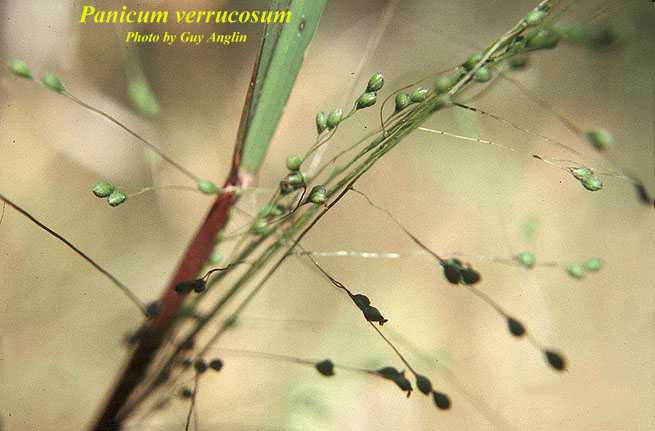Difference between revisions of "Panicum verrucosum"
| Line 44: | Line 44: | ||
===Seed bank and germination=== | ===Seed bank and germination=== | ||
| − | The species showed a significant increase in abundance after tilling (soil disturbance) and was abundant in seed banks.<ref name=kir/> Germination depends on exposed soil and possible disturbance caused by drought.<ref> Kirkman, L. K. and R. R. Sharitz (1994). "Vegetation disturbance and maintenance of diversity in intermittently flooded Carolina bays in South Carolina." Ecological Applications 4: 177-188. </ref> | + | The species showed a significant increase in abundance after tilling (soil disturbance) and was abundant in seed banks.<ref name=kir/> Germination depends on exposed soil and possible disturbance caused by drought.<ref> Kirkman, L. K. and R. R. Sharitz (1994). "Vegetation disturbance and maintenance of diversity in intermittently flooded Carolina bays in South Carolina." Ecological Applications 4: 177-188.</ref> |
===Fire ecology=== <!--Fire tolerance, fire dependence, adaptive fire responses--> | ===Fire ecology=== <!--Fire tolerance, fire dependence, adaptive fire responses--> | ||
Revision as of 12:50, 8 June 2021
| Panicum verrucosum | |
|---|---|

| |
| Photo by Guy Anglin, Atlas of Florida Vascular Plants | |
| Scientific classification | |
| Kingdom: | Plantae |
| Division: | Magnoliophyta - Flowering plants |
| Class: | Liliopsida – Monocotyledons |
| Order: | Poales |
| Family: | Poaceae ⁄ Gramineae |
| Genus: | Panicum |
| Species: | P. verrucosum |
| Binomial name | |
| Panicum verrucosum Muhl. | |

| |
| Natural range of Panicum verrucosum from USDA NRCS Plants Database. | |
Common name: Warty panicgrass[1]
Contents
Taxonomic notes
Synonyms: none.[1]
Varieties: none.[1]
Description
Panicum verrucosum is an annual graminoid species.[2] It has a decumbent to sprawling growth with purple-spotted culms that are 2-7 dm long. The leaves are cauline, 15 cm long, and 2-10 mm wide. The nodes, internodes, leaves, and sheaths are glabrous. The panicle is 10-30cm long and 8-15 cm broad with ascending branches. The spikelets are obovoid, 1.5-2 mm long, and tuberculate with elongate pedicels.[3]
Distribution
P. verrucosum ranges from Massachusetts and Pennsylvania, west to Michigan and Indiana, and south to Florida and southeastern Texas.[1]
Ecology
Habitat
P. verrucosum occurs in moist to wet, sandy, or loamy soils, including sandy loam, loamy sand, and sandy peat.[4] It can be found in pine-wiregrass savannas, wooded floodplains, pond pine-titi peat swamps, sandhills, cabbage palm-mixed hardwood hammocks, and bordering bodies of water, including Cypress-gum ponds, lakes, Hypericum bogs, and ephemeral depression marshes.[4] Furthermore, this species appears in some disturbed areas, including near trails and borrow pits, and in ditches, clear-cuts, and power line corridors.[4] P. verrucosum responds positively or not at all to soil disturbance by clearcutting and roller chopping in North Florida.[5] It also responds positively to soil disturbance by clearcutting and chopping in North Florida flatwoods forests.[6]
Associated species include Pinus palustris, Andropogon ternarius, Muhlenbergia expansa, Aristida stricta, Cyrilla, Ilex, Myrica, Cypress, Liquidambar styraciflua, Hypericum, Xyris, Rhynchospora, Schizachrium, Eupatorium, Scleria, Plea, and Zigadenus.[4]
Panicum verrucosum is an indicator species for the Upper Panhandle Savannas community type as described in Carr et al. (2010).[7]
Phenology
This species flowers from August to October.[1][8]
Seed dispersal
This species is thought to be dispersed by gravity.[9]
Seed bank and germination
The species showed a significant increase in abundance after tilling (soil disturbance) and was abundant in seed banks.[2] Germination depends on exposed soil and possible disturbance caused by drought.[10]
Fire ecology
P. verrucosum is found in cut-burned areas of a Chamaecyparis thyoides stand in the Great Dismal Swamp.[11]
Conservation and management
Cultivation and restoration
Photo Gallery
References and notes
- ↑ 1.0 1.1 1.2 1.3 1.4 Weakley, A.S. 2015. Flora of the southern and mid-atlantic states. Working Draft of 21 May 2015. University of North Carolina at Chapel Hill, Chapel Hill, North Carolina.
- ↑ 2.0 2.1 Kirkman, L. K. and R. R. Sharitz (1994). "Vegetation disturbance and maintenance of diversity in intermittently flooded Carolina bays in South Carolina." Ecological Applications 4: 177-188.
- ↑ Radford, A. E., Ahles, H. E., & Bell, C. R. (1968). Manual of the vascular flora of the Carolinas. Chapel Hill: University of North Carolina Press.
- ↑ 4.0 4.1 4.2 4.3 Florida State University Robert K. Godfrey Herbarium database. URL: http://herbarium.bio.fsu.edu. Last accessed: June 2014. Collectors: Loran C. Anderson, John B. Nelson, Sidney McDaniel, L. J. Brass, Paul O. Schallert, R. Kral, R.K. Godfrey, James P. Gillespie, Angus Gholson, A. H. Curtiss, D. B. Ward, J. Hunter, F. S. Ward, Cecil Slaughter, R. A. Norris, and R. Komarek. States and Counties: Florida: Alachua, Baker, Calhoun, Duval, Franklin, Gadsden, Gulf, Highlands, Jefferson, Lafayette, Leon, Liberty, Nassau, Okaloosa, Osceola, Putnam, Seminole, Taylor, Wakulla, and Walton. Georgia: Atkinson, Grady, and Thomas.
- ↑ Lewis, C.E., G.W. Tanner, and W.S. Terry. (1988). Plant responses to pine management and deferred-rotation grazing in north Florida. Journal of Range Management 41(6):460-465.
- ↑ Moore, W.H., B.F. Swindel, and W.S. Terry. (1982). Vegetative Response to Clearcutting and Chopping in a North Florida Flatwoods Forest. Journal of Range Management 35(2):214-218.
- ↑ Carr, S.C., K.M. Robertson, and R.K. Peet. 2010. A vegetation classification of fire-dependent pinelands of Florida. Castanea 75:153-189.
- ↑ Nelson, G. PanFlora: Plant data for the eastern United States with emphasis on the Southeastern Coastal Plains, Florida, and the Florida Panhandle. www.gilnelson.com/PanFlora/ Accessed: 19 MAY 2021
- ↑ Kirkman, L. Katherine. Unpublished database of seed dispersal mode of plants found in Coastal Plain longleaf pine-grasslands of the Jones Ecological Research Center, Georgia.
- ↑ Kirkman, L. K. and R. R. Sharitz (1994). "Vegetation disturbance and maintenance of diversity in intermittently flooded Carolina bays in South Carolina." Ecological Applications 4: 177-188.
- ↑ McKinley, C. E. and F. P. Day (1979). "Herbaceous production in cut-burned, uncut-burned and control areas of chamaecyparis thyoides (L.) BSP (Cupressaceae) stand in the Great Dismal Swamp." Bulletin of the Torrey Botanical Club 106: 20-28.